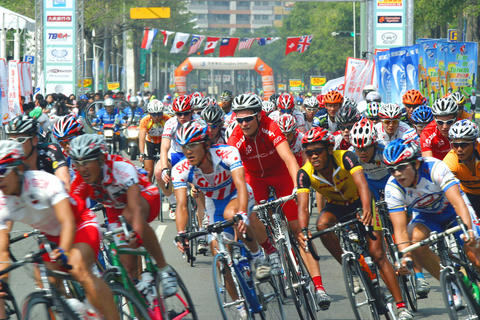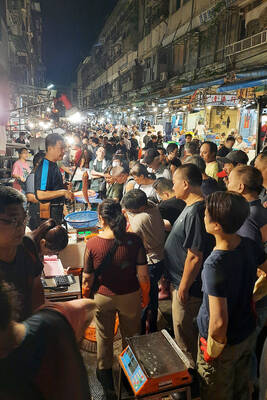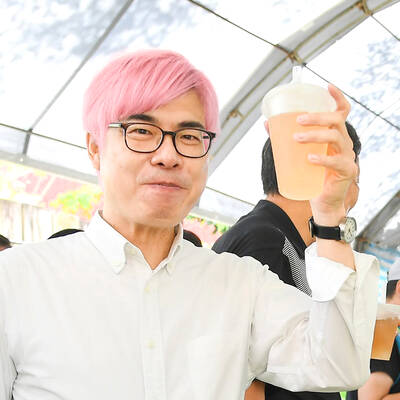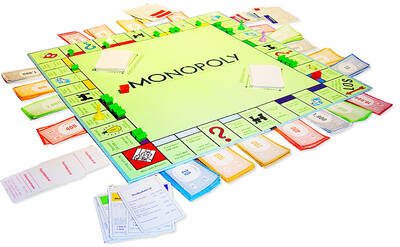This morning, 20 teams participating in the Tour de Taiwan, the island's premier bicycling event, will struggle through Stage Five of the race: 148.3km around Hsinchu. It's the most grueling stretch of the competition.
As of press time, Giant Asia Racing Team was in the lead, but with four stages left it's still anybody's race. Tomorrow, the racers are scheduled to arrive in Taipei County and will complete the race with two final stages in Taipei City.
The Tour de Taiwan has been moving north throughout the week. The race started in Kaohsiung, looped through Pingtung and then headed to Changhua, Taichung and Hsinchu on the east coast.

PHOTO: CNA
Tour de Taiwan is part of the Union Cycliste Internationale (UCI) Asian Tour and since 2006 has been integrated into the Taipei Cycle Show, organized by Taiwan External Trade Development Council (see story above).
With five local teams, out of 20, the event is a major training ground for local cyclists who have ambitions to join the international circuit. There are also teams from Japan, Hong Kong, Indonesia, Canada, the UK, US, Holland, South Korea and Australia.
During the event, Taiwan promotes its cycling industry. This year, both Giant and Merida, Taiwan's largest cycling manufacturers have teams: longtime rivals Merida Europe and Giant Asia Racing Teams. While both feature international stars, they also give locals a chance to show their potential.
The total race covers 800km, with both road race and circuit elements. Saturday's race around the Nangang Exhibition Center also highlights the important role played by Taiwan in the production of top-end cycling components.
For those who want to watch the races, the fifth stage will be setting out from the plaza in front of the Hsinchu City Government building (新竹市政府前) at 9am today. The 127.7km leg in Taipei County will set off at 10am tomorrow from the plaza in front of the Taipei County Government building in Banqiao, cross the Guandu Bridge and finish at the same location. Racers are expected to complete the leg around 1pm. The seventh stage is a circuit race around the Taipei Cycle Show at the Taipei World Trade Center Nangang Exhibition Hall (台北世界貿易中心南港展覽館), which covers a distance of 58km. It starts at 9:30am in front of the main entrance to the exhibition hall. The event concludes on Sunday with 60 laps around Taipei City Government building, along Songgao (松高路), Songzhi (松智路), Songshou (松壽路) and Shifu roads (市府路), starting at 10am.
Updated information can be found at the Tour de Taiwan Web site at www.khhtri.org.tw/tourdetaiwan.

Taiwan is one of the world’s greatest per-capita consumers of seafood. Whereas the average human is thought to eat around 20kg of seafood per year, each Taiwanese gets through 27kg to 35kg of ocean delicacies annually, depending on which source you find most credible. Given the ubiquity of dishes like oyster omelet (蚵仔煎) and milkfish soup (虱目魚湯), the higher estimate may well be correct. By global standards, let alone local consumption patterns, I’m not much of a seafood fan. It’s not just a matter of taste, although that’s part of it. What I’ve read about the environmental impact of the

It is jarring how differently Taiwan’s politics is portrayed in the international press compared to the local Chinese-language press. Viewed from abroad, Taiwan is seen as a geopolitical hotspot, or “The Most Dangerous Place on Earth,” as the Economist once blazoned across their cover. Meanwhile, tasked with facing down those existential threats, Taiwan’s leaders are dying their hair pink. These include former president Tsai Ing-wen (蔡英文), Vice President Hsiao Bi-khim (蕭美琴) and Kaohsiung Mayor Chen Chi-mai (陳其邁), among others. They are demonstrating what big fans they are of South Korean K-pop sensations Blackpink ahead of their concerts this weekend in Kaohsiung.

The captain of the giant Royal Navy battleship called his officers together to give them a first morsel of one of World War II’s most closely guarded secrets: Prepare yourselves, he said, for “an extremely important task.” “Speculations abound,” one of the officers wrote in his diary that day — June 2, 1944. “Some say a second front, some say we are to escort the Soviets, or doing something else around Iceland. No one is allowed ashore.” The secret was D-Day — the June 6, 1944, invasion of Nazi-occupied France with the world’s largest-ever sea, land and air armada. It punctured Adolf

The first Monopoly set I ever owned was the one everyone had — the classic edition with Mr Monopoly on the box. I bought it as a souvenir on holiday in my 30s. Twenty-five years later, I’ve got thousands of boxes stacked away in a warehouse, four Guinness World Records and have made several TV appearances. When Guinness visited my warehouse last year, they spent a whole day counting my collection. By the end, they confirmed I had 4,379 different sets. That was the fourth time I’d broken the record. There are many variants of Monopoly, and countries and businesses are constantly